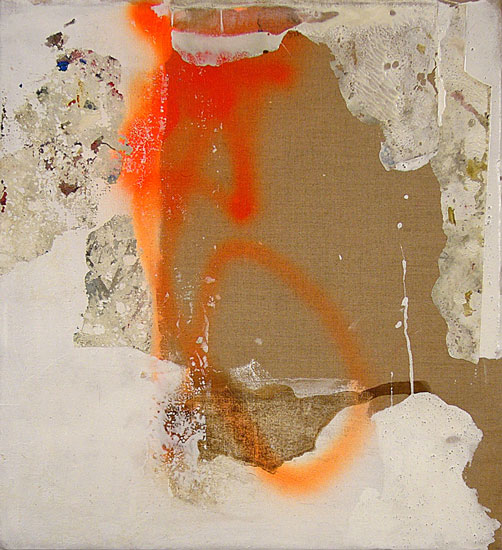
May 2008
Shape Shifters: New York Painters
by Cathy Nan Quinlan

Orange Spray, 2007, 22 x 20" (55.8 x 50.8 cm) acrylic, collaged paper, spray paint on linen
This show is a must-see for the viewer passionate about contemporary painting. It consists of twenty-four painters, each exhibiting one piece and representing the “tip of the iceberg” in two ways: first because these are all mature artists each with a large body of work and second, because they have been selected from the large group of painters currently working in New York City.
One way of looking at the show would be to comb the gallery seeking pleasure in, or rejecting, individual paintings. However, since painters of this level of maturity and quality are so rarely shown together (sad about the Biennial), another option is to try to find out what, if anything, these artists have in common.
To begin with, the paintings have been chosen by James Biederman, who is also a fine painter. It is a pity his work is not in it, because it might provide the key to some of his choices--some, but not all, because he obviously has a roving eye-for works on canvas, that is. There is a preference for abstraction that does not preclude figuration and there is a simple statement in the catalogue emphasizing that all of these painters make their own work. (Was there ever another time when that needed to be pointed out or had the meaning that it has today?) An important aspect to this is that these artists’ works will be more varied and searching and the touch will be more important than for those that embrace mass production.
The show is very well hung, as shows at Sideshow always are-- it makes a great deal of difference. In some instances, superficially similar works are hung next to each other, revealing how dissimilar they are. For example, Don Voisine’s Red Tide and Kazimira Rachfal’s The Polish Rider are, at first glance, both hard-edged geometric paintings, but seen next to each other, Voisine is playing wittily within the lines and Rachfal is willing the edges to evanesce into atmosphere. Though set to one side, Dorothea Rockburne falls somewhere into the abyss separating the two of them, with the aptly titled Wobblies.
Mark Dagley’ Core Belief and James Little’s Psychic are not side-by-side but are respectively the first works you see on entering each of the two rooms. They share many of the same elements; they are large scale and consist of elongated triangles of bright color with taped edges. However, Little’s work is an elaborate optical illusion with the triangles interlocking, while Dagley’s forms are drawn on to a field of raw canvas. Situated near the Dagley, Ben La Rocco and Peter Acheson, in quite different ways, also use the canvas as a field on which to draw.
Information in the computer age is often described as accruing in bits and several painters in the show seem to use separate brushstrokes as metaphors for bytes, notably Joel Longenecker and Jeanne Thomsen working abstractly and Satsuhisa Sakai and Sharon Horvath to build figurative images. Eric Holzman might also be joined to this group and, though his work is not Impressionistic in the depiction of light, it makes one realize that the Impressionists also used the stroke of the brush in this way—to represent separate bits of received information. Related to this way of building the image are two other artists who combine simple or elaborate units, Margrit Lewczuk and Molly Herman.
Chris Martin and Thornton Willis both present a shaped canvas—although Willis’ only appears to be. Willis also builds with bricks, in this case triangles while Martin’s work, below the crudely spray painted dayglow flowers, reveals a sensitive nature similar to those of Bill Jensen and Jacque Rochester’s: they both show gentle, evocative works with a deep love of nature.
Cora Cohen and Russell Roberts’ paintings follow no other law but that in which the first stroke will be made and all the rest will follow intuitively. This is a path of great possibilities; it has all the pleasures and hazards of the open road. Katherine Bradford follows it also with the simple Horses and Piano, leaving it up to the viewer to decide how deceptive her simplicity is. This work has a great joke hovering around it—“Four horses go into a piano bar and the bartender says…”
Richard Temperio’s Red Car in the Country contains a question asked by many others in the show although not quite as directly. A rough translation from the paint: “How can I reconcile the Ego and the Id?” In a reversal of Temperio’s painting in which one peers between gestures to discern formal structures, Cynthia Hartley floats squares on top of a quirky intuitive space.
The categories and connections mentioned here are open to question and the artists in them could be rearranged. What will the art historians of the future make of it? Or will these or other connections seem completely clear to them in some way we can’t predict?
Loren Munk is the interesting oddball of this group, or any other for that matter, and yet in the piece shown here, Greater Williamsburg, he establishes himself as connected to them all by using as his subject matter the aforementioned iceberg. It is a thickly painted map of the Williamsburg neighborhood with artists and galleries and colored lines going from the names to the street addresses, so that the historian at least will be in no doubt as to their locations.